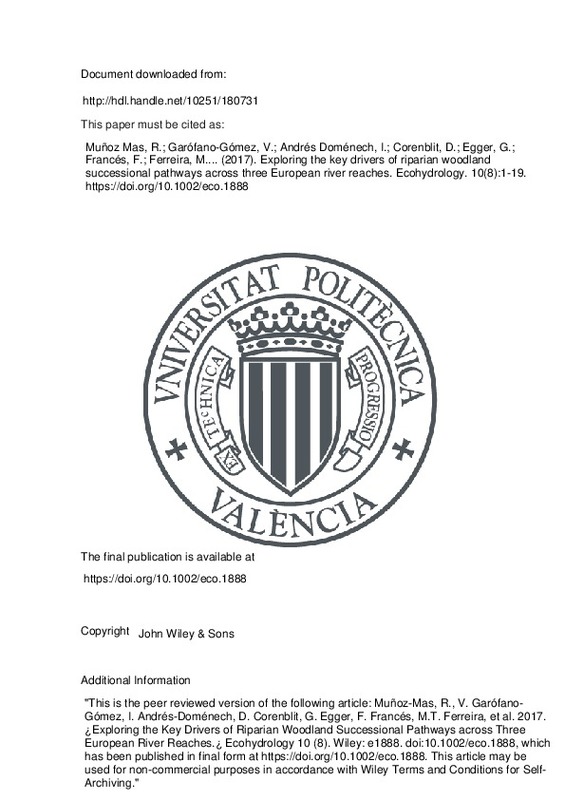|
Resumen:
|
[EN] Climate change and river regulation are negatively impacting riparian vegetation. To evaluate these impacts, process-based models are preferred over data-driven approaches. However, they require extensive knowledge ...[+]
[EN] Climate change and river regulation are negatively impacting riparian vegetation. To evaluate these impacts, process-based models are preferred over data-driven approaches. However, they require extensive knowledge about ecohydrological processes. To facilitate the implementation of such process-based models, the key drivers of riparian woodland successional pathways across three river reaches, in Austria, Portugal, and Spain, were explored, employing two complementary approaches. The principal component analyses highlighted the importance of the physical gradients determining the placement of the succession phases within the riparian and floodplain zones. The generalized additive models revealed that the initial and pioneer succession phases, characteristic of the colonization stage, appeared in areas highly morphodynamic, close in height and distance to the water table, and with coarse substrate, whereas elder phases within the transitional and mature stages showed incremental differences, occupying less dynamic areas with finer substrate. The Austrian site fitted well the current successional theory (elder phases appearing sequentially further up and distant), but at the Portuguese site, the tolerance of the riparian species to drought and flash flood events governed their placement. Finally, at the Spanish site, the patchy distribution of the elder phases was the remnants of formative events that reshaped the river channel. These results highlight the complex relationships between flow regime, channel morphology, and riparian vegetation. The use of succession phases, which rely on the sequential evolution of riparian vegetation as a response to different drivers, may be potentially better reproducible, within numerical process-based models, and transferable to other geographical regions.
[-]
|
|
Código del Proyecto:
|
info:eu-repo/grantAgreement/FCT/SFRH/SFRH%2FBPD%2F47140%2F2008/PT/
...[+]
info:eu-repo/grantAgreement/FCT/SFRH/SFRH%2FBPD%2F47140%2F2008/PT/
info:eu-repo/grantAgreement/EC//ERACCT-2005-026025/
info:eu-repo/grantAgreement/MICINN//CGL2008-03076-E/ES/IWRM-NET - MODELACION DE LA VEGETACION DE RIBERA PARA LA DETERMINACION DE REGIMENES DE CAUDALES ECOLOGICOS/
info:eu-repo/grantAgreement/EC//ERA-IWRM%2F0001%2F2008/
info:eu-repo/grantAgreement/MICINN//CSD2009-00065/ES/Evaluación y predicción de los efectos del cambio global en la cantidad y la calidad del agua en ríos ibéricos/
info:eu-repo/grantAgreement/FCT//SFRH%2FBD%2F52515%2F2014/
info:eu-repo/grantAgreement/MINECO//CGL2013-44917-R/ES/CAMBIOS AMBIENTALES Y ANTROPICOS EN CUENCAS FLUVIALES MEDITERRANEAS: IMPACTOS HISTORICOS EN LA MORFOLOGIA, LOS FLUJOS SEDIMENTARIOS Y LA VEGETACION/
info:eu-repo/grantAgreement/FCT//IF%2F00059%2F2015/
info:eu-repo/grantAgreement/MINECO//CGL2013-44917-R//CAMBIOS AMBIENTALES Y ANTROPICOS EN CUENCAS FLUVIALES MEDITERRANEAS: IMPACTOS HISTORICOS EN LA MORFOLOGIA, LOS FLUJOS SEDIMENTARIOS Y LA VEGETACION/
info:eu-repo/grantAgreement/MICINN//CSD2009-00065//Evaluación y predicción de los efectos del cambio global en la cantidad y la calidad del agua en ríos ibéricos/
[-]
|
|
Descripción:
|
"This is the peer reviewed version of the following article: Muñoz-Mas, R., V. Garófano-Gómez, I. Andrés-Doménech, D. Corenblit, G. Egger, F. Francés, M.T. Ferreira, et al. 2017. ¿Exploring the Key Drivers of Riparian Woodland Successional Pathways across Three European River Reaches.¿ Ecohydrology 10 (8). Wiley: e1888. doi:10.1002/eco.1888, which has been published in final form at https://doi.org/10.1002/eco.1888. This article may be used for non-commercial purposes in accordance with Wiley Terms and Conditions for Self-Archiving."
|
|
Agradecimientos:
|
This work was supported by the IWRM Era-NET Funding Initiative through the RIPFLOW project (references ERACCT-2005-026025, ERA-IWRM/0001/2008, CGL2008-03076-E/BTE), http://www.old.iwrm-net.eu/spip.php, by the Spanish ...[+]
This work was supported by the IWRM Era-NET Funding Initiative through the RIPFLOW project (references ERACCT-2005-026025, ERA-IWRM/0001/2008, CGL2008-03076-E/BTE), http://www.old.iwrm-net.eu/spip.php, by the Spanish Ministry of Economy and Competitiveness through the project SCARCE (Consolider¿Ingenio 2010 CSD2009-00065), and by the project ¿Natural and anthropogenic changes in Mediterranean river drainage basins: historical impacts on rivers morphology, sedimentary flows and vegetation¿ of the Spanish MINECO (CGL2013-44917-R). Virginia Garófano-Gómez received a postdoctoral grant from the Université Blaise Pascal (now: Université Clermont Auvergne). Rui Rivaes benefited from a PhD grant (SFRH/BD/52515/2014) sponsored by Fundação para a Ciência e Tecnologia (FCT) under the FCT PhD programme FLUVIO¿River Restoration and Management. Patricia María Rodríguez González was funded by FCT through an SFRH/BPD/47140/2008 postdoctoral fellowship and through an FCT Investigator Programme grant (IF/00059/2015). The authors also thank all the colleagues and master students who contributed enthusiastically to the field campaigns of this study.
[-]
|







![[Cerrado]](/themes/UPV/images/candado.png)


